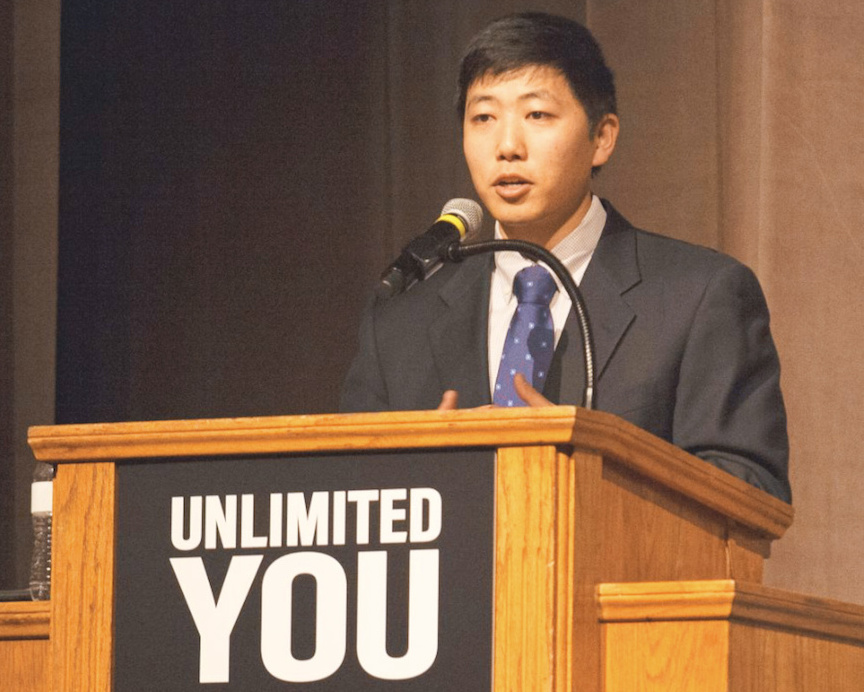SELANOCO JACL President Ryan Yoshikawa
The Anaheim program paves the way for telling the Japanese American incarceration story.
By Ryan Yoshikawa, President, SELANOCO JACL
Each time a program is created to tell the story of what happened to Japanese Americans and their Japanese descendants during their forced evacuation during World War II, one expects to see the same elements put together to tell this 77-year-old story.
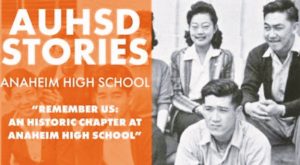 To the surprise of all who attended “The Poston Experience: Paving the Way for the Next Generations” program, presented by the Anaheim Union High School District and Anaheim High School on Aug. 24, the unique interpretations of this story were all done by current Anaheim grade school and high school students on what happened in the City of Anaheim in 1942 and at the Poston War Relocation Center in Arizona during WWII.
To the surprise of all who attended “The Poston Experience: Paving the Way for the Next Generations” program, presented by the Anaheim Union High School District and Anaheim High School on Aug. 24, the unique interpretations of this story were all done by current Anaheim grade school and high school students on what happened in the City of Anaheim in 1942 and at the Poston War Relocation Center in Arizona during WWII.
The “Poston Experience” really started as soon as attendees arrived at Anaheim High School and drove into the parking lot. Everyone was welcomed by Anaheim High School students from the Associated Student Body and the BROS and CROWN student groups.
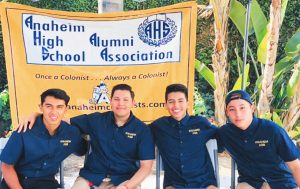
Anaheim ASB students welcomed attendees. (Photo: Ryan Ruelas)
The students did a great job and were so friendly in guiding all of us to the Cook Auditorium. For those with a disability, the students were happy to help direct people to parking options or call for assistance to get attendees into the appropriate entrance to see the program.
As members of the SELANOCO JACL chapter entered the auditorium, we were welcomed by the prerecorded voices of the Anaheim High School Las Sirenas Women’s choir singing “Don’t Fence Me In,” “Don’t Sit Under the Apple Tree” and “Sentimental Journey,” which were the big song hits of the 1940s. We also saw “The Poston Experience” title overlaid with a photo of the Poston camp projected on the main curtain of the stage.
SELANOCO JACL member Patti Hirahara worked with the Anaheim Union High School District and her alma mater of Anaheim High School, since last year, to help put this program together, as well as acted as mistress of ceremonies and moderator during the two-hour event.
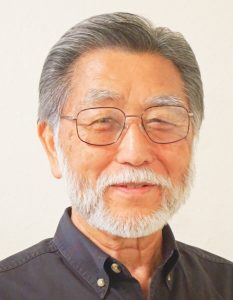
Joe Nakamura is the only Japanese American ASB student body president in Anaheim High School’s 121-year history. He was president of the Class of 1959 and was a special guest at the “Poston Experience” event. (Photo: Patti Hirahara)
Joe Nakamura, student body president of the Anaheim High School Class of 1959, said of Hirahara’s dedication, “In creating opportunities to tell the Japanese American story, she has kept their memories alive, memories that are all too often forgotten, especially by the younger generations. Her work to preserve the history of the Japanese American legacy is priceless.”
Nakamura is the only Japanese American ASB student body president in Anaheim High School’s 121-year history.
What was also impressive to see was the amount of elected officials who were in attendance at the program. Congressman Lou Correa from California’s 46th District; Anaheim City Councilmember Dr. Jose F. Moreno, District 3; Anaheim Union High School District Board of Trustees’ Annemarie Randle-Trejo, clerk, Katherine H. Smith, clerk and Al Jabbar, member; and Anaheim Elementary School District Board of Education Trustees’ Ryan A. Ruelas, president, Dr. J. Paolo Magcalas, clerk and members Jackie Filbeck and Mark Lopez.
The interweaving of in-person and video presentations also heightened the interest of the crowd. AUHSD Superintendent Michael Matsuda kicked-off the event by sharing the history of the significance of having the event at Anaheim High School’s Cook Auditorium.
This is where the 14 Japanese and Japanese American students sat in the front row, in 1942, for a special assembly for the entire student body called by Anaheim Union High School Principal Dr. Paul H. Demaree to tell the students that their Japanese classmates would be leaving for Japanese incarceration camps and saying goodbye.
Dr. Paul H. Demaree in 1943.One of those students happened to be Matsuda’s mother, Ruth Ikeda, who never saw her son become superintendent of the same school district that she and her sisters had attended before WWII.
Demaree, who was born in Japan and spoke fluent Japanese, was also superintendent of the Anaheim Union High School District at that time, and due to his special compassion for his Japanese American students and continued support while they were incarcerated, this program was dedicated in his honor.
Robert Saldivar, who is the first Anaheim High School alumnus to become principal in Anaheim High School’s history, offered his comments on behalf of Anaheim High School and its student body.
Anaheim High School was first established in 1898 and is the oldest high school in the AUHSD and the third-oldest high school in Orange County.
“Anaheim Union High School, as it was called then, was the center of North Orange County education for the Japanese community, not only for those that lived in Anaheim, but also others that lived in neighboring cities where students traveled many miles to go to school by bicycle or even walk,” Saldivar said.
“From 1926-42, there were 70 students of Japanese ancestry who graduated from Anaheim High, with four students not being able to attend their graduation, in 1942, due to their forced removal during WWII,” he added.
Saldivar introduced the first video documentary created by AUHSD Film Academy students entitled “Remembering Us: An Historic Chapter at Anaheim High School,” which set the tone for the entire program.
This touching video featured the story of Ruth Ikeda Matsuda and her children, Superintendent Matsuda and Jackie Counts, who reminisced about life in Anaheim at that time and how former AUHSD Superintendent Jan Billings, who was in attendance, agreed to a suggestion by Michael Matsuda to have surviving Anaheim High School Japanese American students return to receive their diplomas along with the Anaheim High School Class of 1997 at their commencement, 50 years later.
There was also a commentary from Demaree’s daughter, Gania Demaree-Trotter, who was a special guest at the event. This presentation was able to show how deep the roots of Japanese American heritage is at Anaheim High School. There was also a group photo of the only Japanese club that existed from 1941-42.
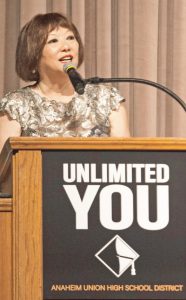
Patti Hirahara at her alma mater, Anaheim High School, where she graduated in 1973. (Photo: Shane Sato)
Hirahara gave a brief history of the early Anaheim Japanese pioneer community. They came to Anaheim in the early 1900s and established local community businesses, as well as worked on truck farms and ranches. The community even established an Anaheim Japanese Business Assn.
The Anaheim Japanese Free Methodist Church and a Japanese language school were also created in the city before the war.
In 1940, there were 567 Japanese living in Anaheim, with 221 being born in Japan and 346 being born in the U.S. or elsewhere. There are also 63 Japanese Americans and their descendants buried in Anaheim’s Cemetery, with the first being Joe Ogihara in 1907.
Anaheim High School Dance Production students also did a video tribute titled “Cherry Blossom” for the Poston Experience, choreographed by Dance Director Oscar Gonzalez, to the music of the old Japanese folk song “Sakura.” It was a moving piece, portraying an interpretation of their emotions of the Japanese American incarceration within our own country.
The 800 people in attendance saw reminders on the stage of two duffle bags labeled with the words “Never Forget” and “All We Can Carry,” along with two suitcases with a Japanese designed paper umbrella to remind the audience of what worldly possessions all the Anaheim Japanese pioneers had left to take with them when they departed their beloved city to go to a life of uncertainty.
Marlene Shigekawa, whose family is an Anaheim Japanese pioneer, is president of the Poston Community Alliance, and Poston is where the residents of Anaheim and the majority of Orange County JAs went during WWII.
Her video presentation entitled “The Shigekawa Family Journey — An American Story” showed a detailed video, produced by Shigekawa, of her family’s time from Orange County to Poston and after the war along with some footage of the Poston War Relocation Center and its history.
The first part of the program concluded with a video presentation by the Anaheim Elementary School District that was introduced by Superintendent Dr. Christopher Downing. The video portrayed some of the history of Poston’s grade school situation at that time.
A small group of Anaheim elementary school students sang two songs that were created in Poston Camp One’s grade schools in 1943 and ’44 entitled “Safety Everywhere” by June Yasukochi and “The Postman,” which was uncovered in Poston WRA records. In seeing the children sing those songs, it was a flashback to those times and reminded us how things have not really changed after all these years.
To bring a personal perspective to the “Poston Experience” story, a panel discussion was highlighted by photographs and newspaper articles that related to each participant. Two gentlemen on the panel, who have deep roots in Orange County’s Japanese American community, spoke of their experiences as a Congressional Gold Medal recipient and a member of the Boy Scouts in Poston, respectively.
Don Miyada joined the 100th Infantry Battalion, 442nd Regimental Combat Team in 1944 and is one of the oldest survivors of the most-decorated unit for its size and length of service in the entire history of the U.S. Military. He has been very active with the Go For Broke National Education Center and shared his experiences in being honored with the Congressional Gold Medal in Washington, D.C., for his service to his country.
Robert M. Wada, who donated his Poston Boy Scout uniform to the Smithsonian National Museum of American History’s Japanese American Collection in 2017, shared his personal story of the hatred and racism he experienced as a young boy in his Boy Scout uniform when he was on an outing outside of Poston. Wada, a Marine and Korean War veteran, has chartered many organizations as president and is the author of “From Internment to Korea to Solitude.”
Shigekawa also served on the panel discussion. She was born in the Poston War Relocation Center along with her older brother, Gerald. She was the first in her family to go back to Poston and learn about the place of her birth. Shigekawa was happy to come back to Anaheim High School and be joined by Shigekawa family descendants from across the U.S., as well as her Anaheim High School classmates from the Class of 1962.
All of the attendees were impressed with the unscripted presentation by panelist Demaree-Trotter, who is 92 years old and an alumna of the Anaheim Union High School Class of 1944. As the daughter of principal Dr. Paul Demaree, her profound remarks of the incarceration and the importance of this program were amazing, and at the conclusion of her comments, she received a standing ovation from the audience. Her remarks were put on YouTube and as of this writing, she has had almost 3,000 views.
Last but not least was panelist Tom Leatherman, representing the National Park Service’s Japanese American Confinement Sites Grant Program. The JACS Grant program encourages and supports the preservation and interpretation of historic Japanese American confinement sites during WWII. Leatherman gave the audience a better idea about what the program has been doing since its establishment in 2009.
In addition, Leatherman’s appearance with the panel coincided with the City of Anaheim Public Library’s new 5,000-square-foot exhibition “I AM AN AMERICAN: Japanese Incarceration in a Time of Fear,” which opened for a special preview that afternoon at the city’s MUZEO Museum and Cultural Center in Downtown Anaheim; the exhibit will close on Nov. 3.
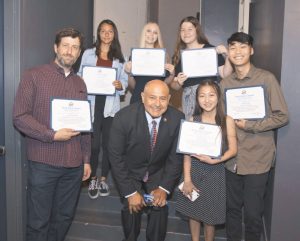
Congressman Lou Correa (center) and students from the AUHSD Film Academy with adviser Jeff Numainville (left)
As a surprise to the panel participants, Congressman Correa presented each with a United States Congress House of Representatives Certificate of Special Recognition. The wording on the certificate was uniquely important and said, “I join with Congress to honor your participation in ‘The Poston Experience — Paving the Way for the Next Generations’ program to educate the community about the incarceration of Anaheim’s Japanese Americans during World War II.”
He also honored the young filmmakers who created the Anaheim High School documentary, as well as the SELANOCO JACL for its participation.
Janet Brown, president of the Anaheim High School Alumni Assn., concluded the program and offered her thanks to all who came to the “Poston Experience” event.
“Without the help of the Anaheim High School Alumni Assn., many aspects of coordinating the event with the students and public would not have been possible,” said Hirahara.
Comments from community leaders, attendees and students gave high marks utilizing the words of excellent, impressive and well-done to summarize their feelings about the event. Many were surprised at how much they did not know about this time in history. In addition, students who attended the event are now asking their teachers when they will be teaching them more about what happened during this time in history.
“We at the AESD were so honored to be a part of the ‘Poston Experience’ event,” said AESD’s Ruelas. “As an educator and trustee, I believe it is superimportant that our students in the AESD and AUHSD hear the stories of the WWII era and the fear that plagued society during that time. History is important so that we learn from our mistakes and not make the same errors of the past and prevent an event like Poston from happening again. It was an amazing event, so informative, and we at the AESD were proud to be part of this experience.”
I was happy to represent the South East Los Angeles and North Orange County (SELANOCO) chapter of the JACL and the next generation of community leaders, as the SELANOCO chapter president. We were proud to support the Anaheim Union High School District in having this event. It focused on giving Anaheim High School students a chance to connect with the story of the Japanese American incarceration and showed how our entire community can come together to present the history of Anaheim and Orange County.
The program was also able to give a great stage for the students of local Anaheim schools to help share the tragic story of the incarceration of Japanese Americans. It brought community members together to remember the strength it took to rise above the difficult post-war years, as well as present the story from the perspective of young students.
This rejuvenation is something the incarceration story needed, as the generations who survived the camps are passing away. It’s been 74 years since the closing of the camps, and we still need to stand together against injustice to all people. We hope programs such as this continue to be created and pushed to give more people a chance to give their insights on this tragic time in U.S. history.
Supporting organizations for the event were the Anaheim High School Alumni Assn., the Poston Community Alliance, the Anaheim Elementary School District and the SELANOCO JACL.
To view some of the videos shown during the event, please visit @AZPostonAHS on Facebook.
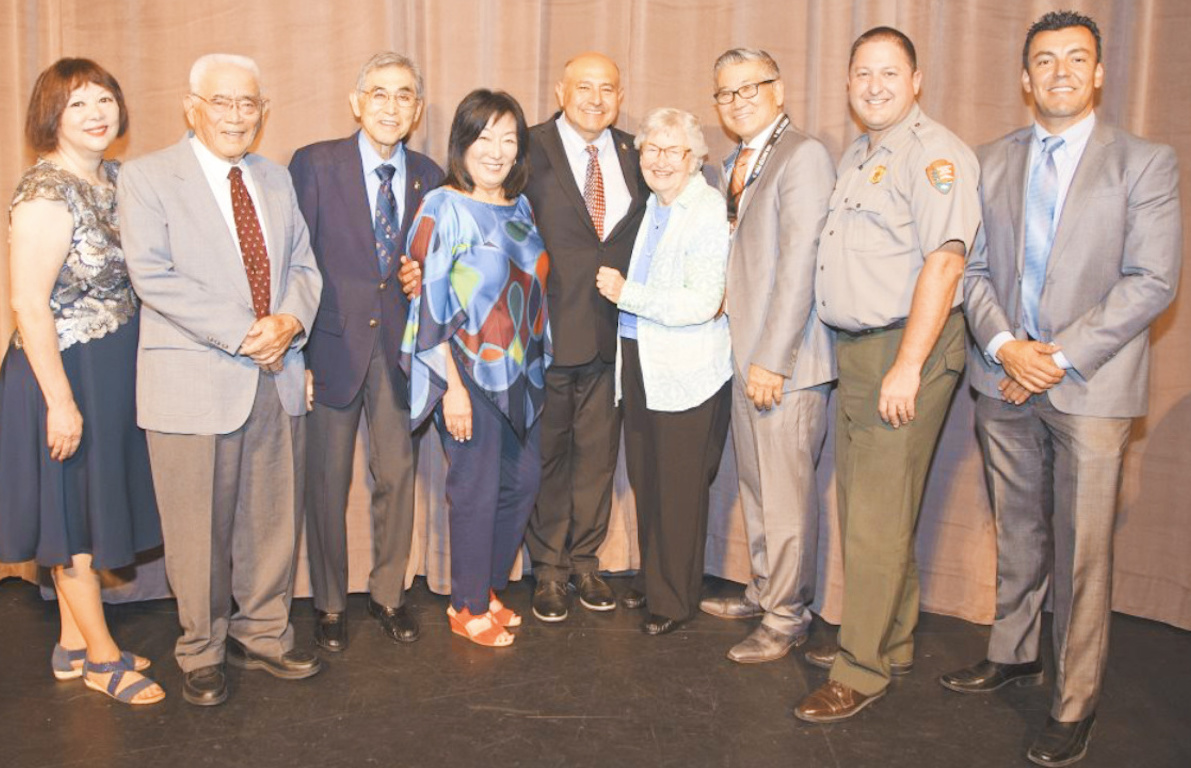
“Poston Experience” participants (from left) Patti Hirahara, Don Miyada, Robert M. Wada, Marlene Shigekawa, Congressman Lou Correa (Calif.-46th District), Gania Demaree-Trotter, AUHSD Superintendent Michael Matsuda, NPS Japanese American Confinement Sites Grant Pacific West Region Representative Tom Leatherman and Anaheim High School Principal Robert Saldivar (Photo: Shane Sato)

